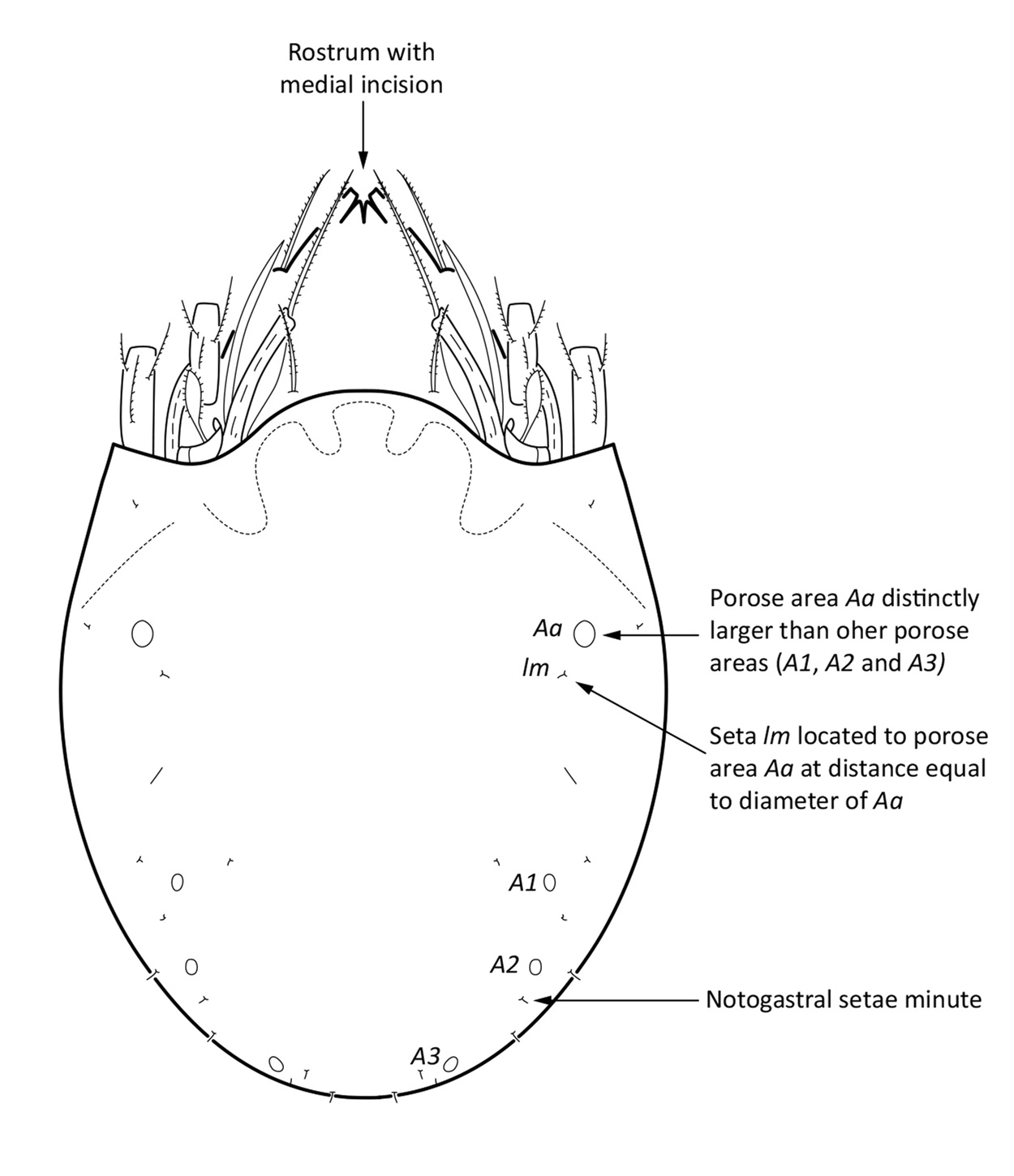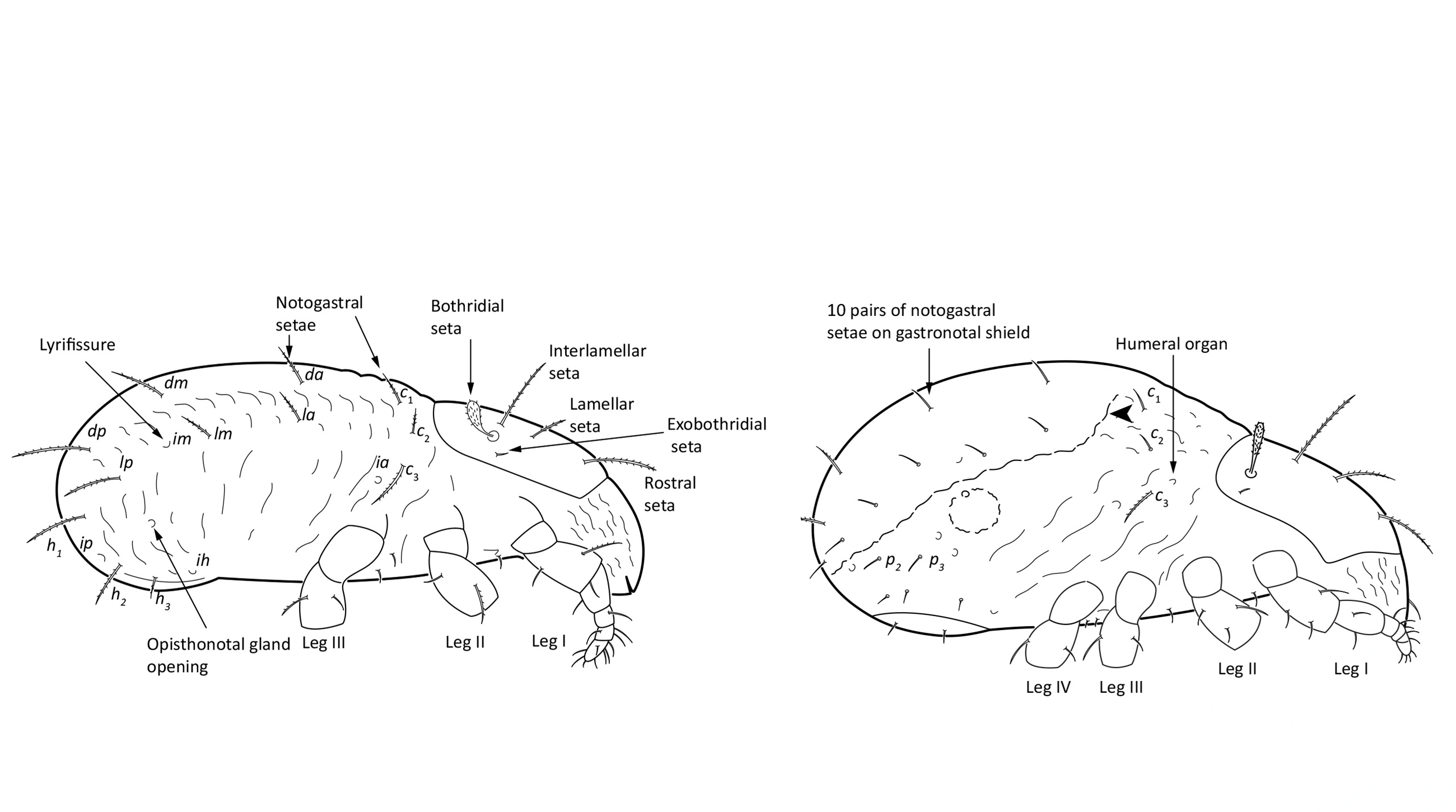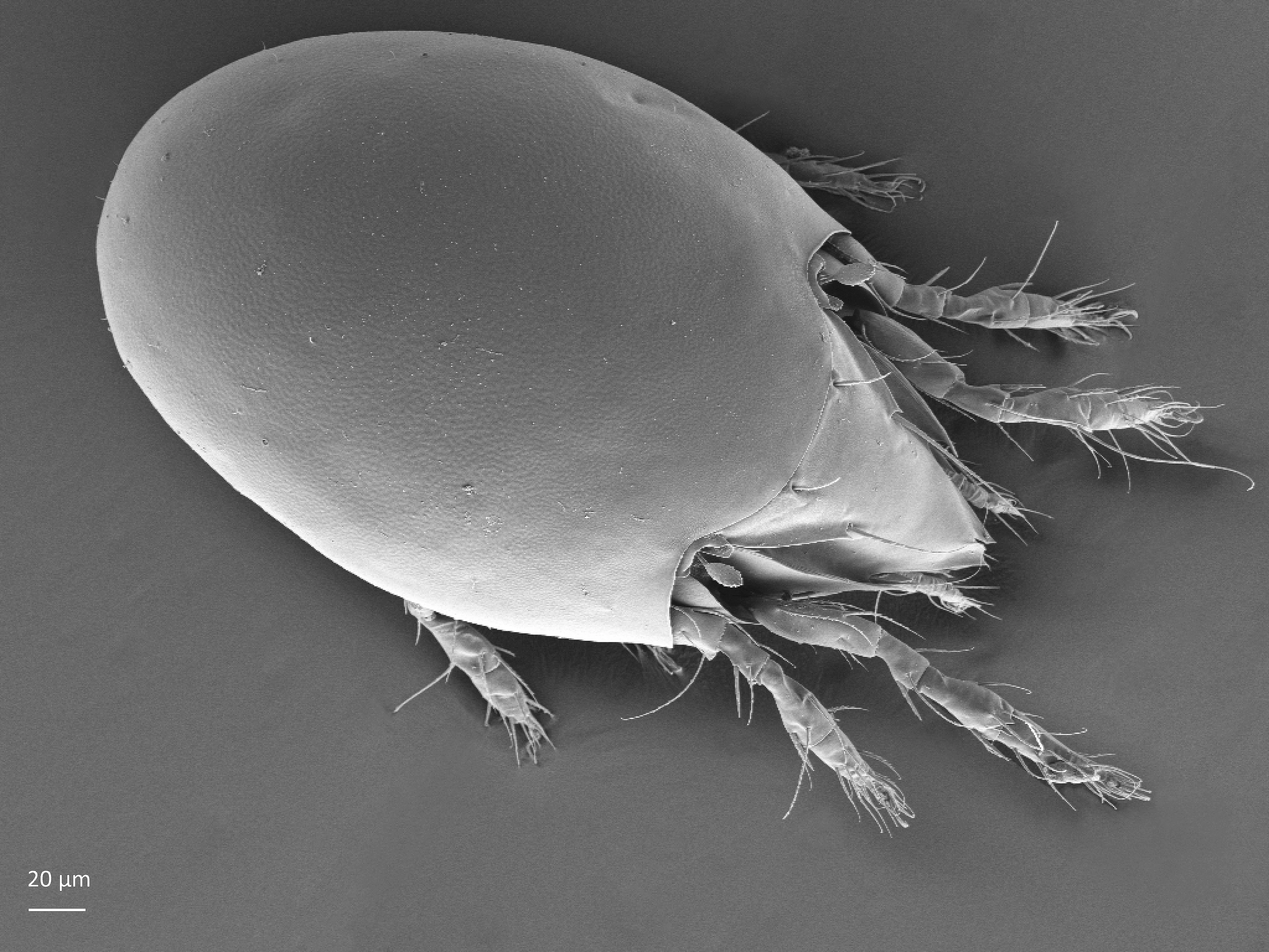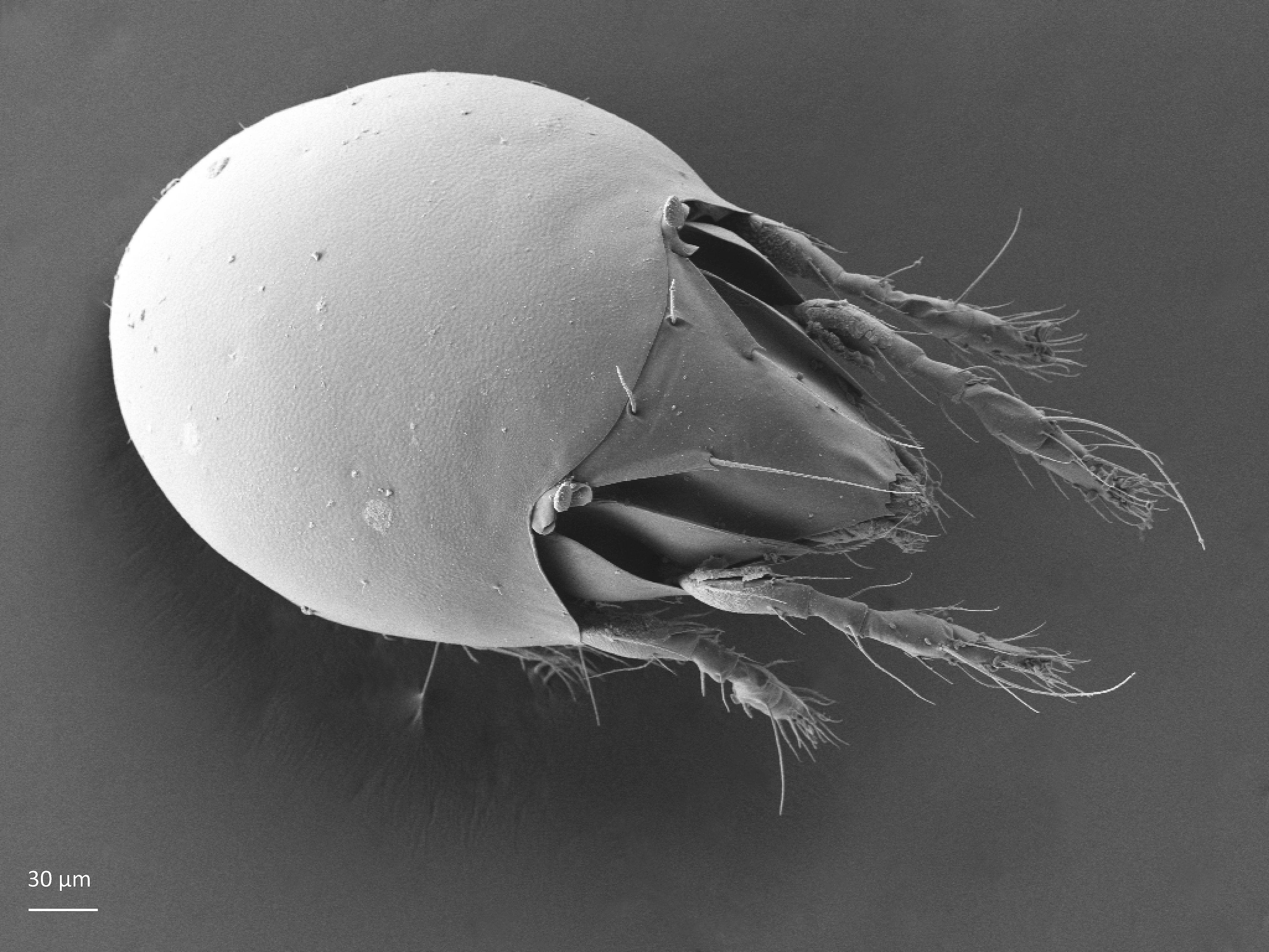Chamobates borealis
Chamobates borealis is a forest species, found mainly in soil. In Norway it is common and abundant in forests, but has been also found in Svalbard tundra. It reproduces sexually and feeds on fungi and lichens. It can be confused with C. pusillus, although both species differ on the molecular and morphological level.
Description

Fig. 1. Dorsal view of Chamobates borealis, adult.
Adult: The length of the body is 325–384 µm, and the width is 202–247 µm. The color is middle brown. Rostrum has a medial incision and two lateral teeth (Fig. 1). Bothridial seta is clavate, and finely barbed. Prodorsal lamellar seta is long, rostral setae and interlamellar setae are of medium size and exobothridial seta is short. Lamella is well developed and has a cusp with outer tooth; translamella is absent. Notogastral setae are minute. Porose area Aa is distinctly larger than other porose areas (Fig. 2). Seta lm is located posterior-medially to porose area Aa at the distance equal to the diameter of Aa (Fig. 1).
Juvenile stages: Larva: body length 198 µm, width 93 µm. Protonymph: body length 248 µm, width 122 µm. Deutonymph: body length 290 µm, width 136 µm. Tritonymph: body length 345 µm, width 191 µm. The color is whitish. The larva does not have a gastronotal shield (Fig. 3), whereas such shield is present in the nymphs (marked by arrowhead in Fig. 4). Ten pairs of setae are present on gastronotal shield, while setae p2, p3 and of c-series are inserted on unsclerotized cuticle.

Fig 3 (left). Lateral view of Chamobates borealis, larva.
Fig 4 (right). Lateral view of Chamobates borealis, tritonymph.
Look-alikes
Fig. 5. Rostrum of Chamobates borealis with incision.
Fig. 6. Rostrum of Chamobates pusillus without incision.
Chamobates borealis is sometimes confused with C. pusillus, but these species differ from each other, both on the molecular and morphological level. Adult of C. borealis has a medial incision on the rostrum (marked by arrowhead in Fig. 5), which is absent in C. pusillus (Figs 6 and 7). In C. borealis notogastral setae are minute, while in C. pusillus most of these setae are alveolar (alveoli of setae, i.e. small cavities, remain). In C. borealis porose area Aa is distinctly larger than other porose areas (Fig. 2), and in C. pusillus it is only slightly larger than other porose areas. In C. borealis seta lm is located posterior-medially to porose area Aa at the distance equal to the diameter of Aa (Fig. 1), and in C. pusillus this seta is located medially from Aa at the distance of two times diameter of Aa (Fig. 6). The nymphs of C. borealis have a humeral organ (Fig. 4), which is absent in C. pusillus (Fig. 8).
Biology

Fig. 8. Lateral view of Chamobates pusillus, nymph.
Chamobates borealis reproduces sexually. Its development has not yet been studied, but is probably similar as in C. subglobulus (Oudemans, 1900), which developed from egg to adult during 71–124 days in 18–20°C. Chamobates borealis is a microphytophagous, fungivorous browser (it is only able to digest trehalose).
Ecology
Distribution
This species is found in the Holarctic, which is the northern continents of the world.
Habitat
It is considered silvicolous, a forest species, and is found mainly in soil.
Findings in Norway
In Norway Chamobates borealis commonly occurs in forests. In a broadleaf forest in Kvam in Western Norway, it was the second most abundant oribatid species, it made up 17% of all Oribatida. It has been found in a wide range of microhabitats, like mosses on ground, tree bark, stump, dead wood, and in dead wood, but seemed to be most abundant in mosses growing on dead wood. Chamobates borealis has also been found in Svalbard.
References
Seniczak A, Bolger T, Roth S, Seniczak S, Djursvoll P and Jordal BH (2019). Diverse mite communities (Acari: Oribatida, Mesostigmata) from a broadleaf forest in western Norway. Annales Zoologici Fennici 56(1), 121–136. doi.org/10.5735/086.056.0111
Seniczak A, Seniczak S and Jordal BH (2019). Integrated taxonomy approach: molecular data and ontogeny studies clarify systematic status of Chamobates borealis (Acari, Oribatida). Systematic and Applied Acarology 24(12), 2409–2426. doi.org/10.11158/saa.24.12.9
Seniczak A, Seniczak S, Iturrondobeitia JC, Solhøy T and Flatberg KI (2019). Diverse Sphagnum mosses support rich moss mite communities (Acari, Oribatida) in mires of western Norway, Wetlands doi.org/10.1007/s13157-019-01236-w
Seniczak A and Seniczak S (2020) Diversity of oribatid mites (Sarcoptiformes) in the Svalbard Archipelago: a historical overview. Zootaxa 4834 (1), 041–065. doi.org/10.11646/zootaxa.4834.1.3.
Shaldybina ES (1971). Development of two oribatid mites of the genus Chamobates Hull, 1916 (Oribatei, Chamobatidae). Scientific Notes of the Gorky State Pedagogical Institute. Gorky State Pedagogical University, Gorky, 116, 51–71. [In Russian]
Subías LS (2004). Listado sistemático, sinonímico y biogeográfico de los ácaros oribátidos (Acariformes, Oribatida) del mundo (excepto fósiles). Graellsia 60 (número extraordinario), 3–305.
Thunes KH, Skartveit J, Gjerde I, Starý J, Solhøy T, Fjellberg A, Kobro S, Nakahara S, zur Strassen R, Vierbergen G, Szadziewski R, Hagan DV, Grogan Jr WL, Jonassen T, Aakra K, Anonby J, Greve L, Aukema B, Heller K, Michelsen V.,Haenni J-P, Emeljanov AF, Douwes P, Berggren K, Franzen J, Disney RHL, Prescher S, Johanson KA, Mamaev B, Podenas S, Andersen S, Gaimari SD, Nartshuk E, Søli GEE, Papp L, Midtgaard F, Andersen A, von Tschirnhaus M, Bächli G, Olsen KM, Olsvik H, Földvári M, Raastad JE, Hansen LO and Djursvoll P (2004). The arthropod community of Scots pine (Pinus sylvestris L.) canopies in Norway. Entomologica Fennica 15, 65–90.
Weigmann G (2006). Hornmilben (Oribatida). Die Tierwelt Deutschlands. 520 pp. Vol. 76, Goecke and Evers, Keltern.
Siden siteres som:
Seniczak A (2020). Chamobates borealis (Trägårdh, 1902). www.artsdatabanken.no/Pages/286333. Nedlastet <dag/måned/år>



